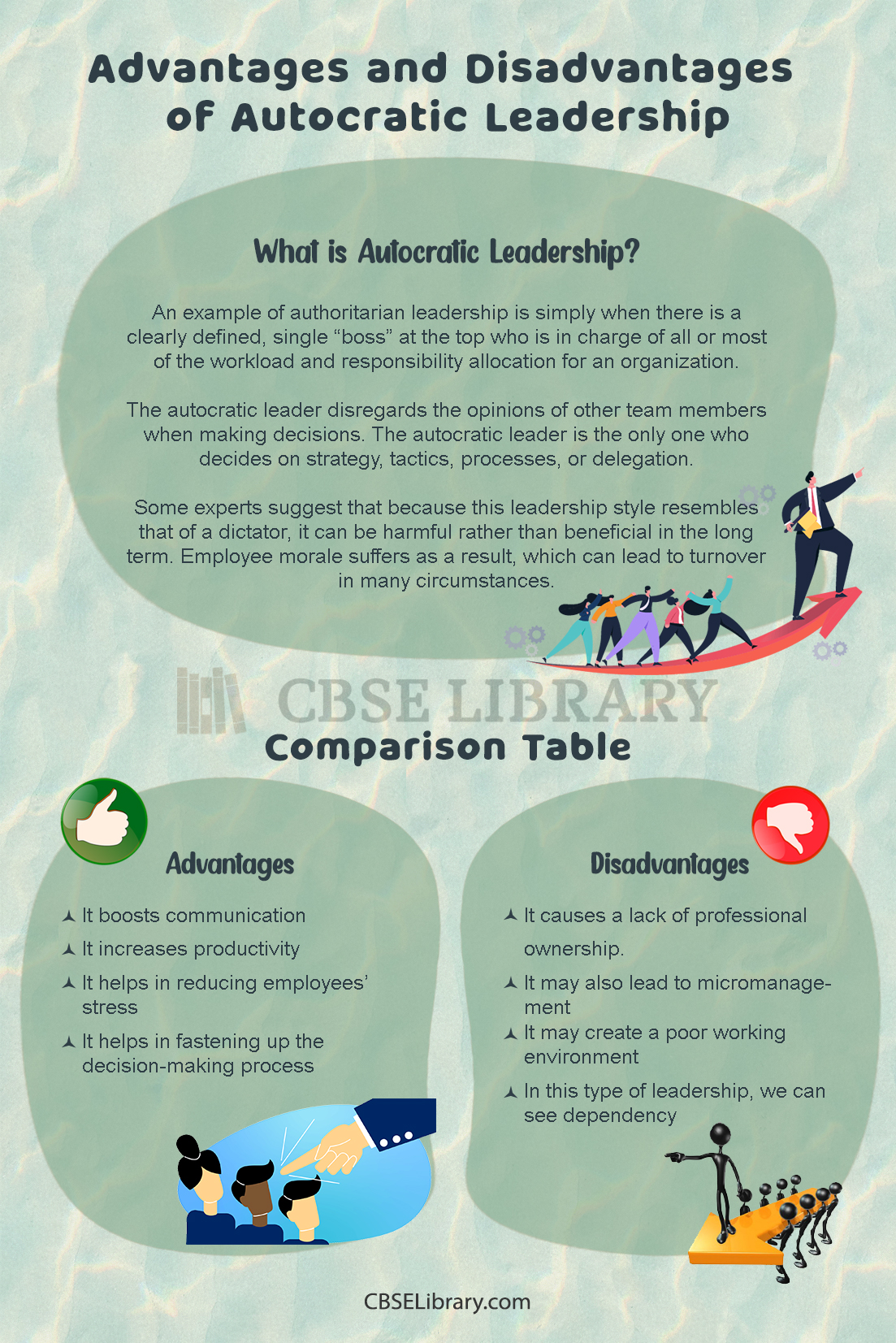Autocratic Leadership Advantages And Disadvantages: Autocratic leadership is a management style in which one person, usually a leader or a member of the organisation, makes decisions on the company’s behalf. This form of leadership is particularly common in small organisations with a limited number of employees.
Only organisations where the nature of the work necessitates swift decision-making will benefit from this leadership style. In this case, the leader is fully responsible for the choice and its outcome. It is regarded as a flexible leadership style; however, some claim that the style has passed its prime.
The authoritarian leader, however, has several characteristics, such as not listening to other members of the group and dictating all tasks, as well as not recognizing or rewarding employees to increase morale.
There are, nevertheless, certain advantages to autocratic leadership. It enables speedy decision-making, control over a company’s procedures and activities, and so on.
In cases where a company is constantly changing or facing a crisis, autocratic leadership will be beneficial. Because of its streamlined organisational structure and ability to make quick decisions, it will be able to react to situations more quickly than other leadership styles.
Students can also find more Advantages and Disadvantages articles on events, persons, sports, technology, and many more.
What is Autocratic Leadership? Advantages and Disadvantages of Autocratic Leadership 2022
An example of authoritarian leadership is simply when there is a clearly defined, single “boss” at the top who is in charge of all or most of the workload and responsibility allocation for an organization.
The autocratic leader disregards the opinions of other team members when making decisions. The autocratic leader is the only one who decides on strategy, tactics, processes, or delegation.
Some experts suggest that because this leadership style resembles that of a dictator, it can be harmful rather than beneficial in the long term. Employee morale suffers as a result, which can lead to turnover in many circumstances.
- Advantages of Autocratic Leadership
- Disadvantages of Autocratic Leadership
- Comparison Table for Advantages and Disadvantages of Autocratic Leadership
- FAQ’s on Autocratic Leadership Advantages And Disadvantages
Characteristics of Autocratic leadership
The autocratic boss discourages his employees from contributing fresh ideas: Any project that an autocratic leader lead has well-defined standards and outcomes. As a result, he methodically plans out every aspect and does not invite his team members to make strategic ideas. He merely wants them to follow his orders.
Quick decision-making is facilitated under autocratic leadership: The firm managed by an authoritarian CEO is agile and better positioned to respond to any changes due to the tightly controlled style of operations. This is due to the fact that decision-making is centralised, therefore the leader makes a swift choice and the company follows suit.
An autocratic leader is knowledgeable: In almost any project or organisation, an autocratic leader is the only pushing force. He possesses knowledge that is superior to that of his colleagues in his profession, allowing him to take hold of a leadership position and make sound judgments on his own.
Employees have very limited flexibility in this style: The ways of functioning under authoritarian leadership are highly inflexible, allowing for little modification or improvisation on the part of the employees. The team members have very little functional flexibility as a result of this.

Advantages of Autocratic Leadership
It establishes a clear chain of command within organisations: Organizations benefit from autocratic leadership styles because they provide structure, establish clear norms, and simplify communication. People who work under an autocratic leader will know who to speak with and who to seek permission from. Not only will this improve organisational efficiency, but it will also promote accountability.
It can be used to compensate for inexperience or skill gaps: One of the advantages of autocratic leadership is that it can assist an inexperienced team in accomplishing goals that they otherwise would not be able to accomplish on their own. Autocrats can increase turnaround times and quality standards by giving clear instructions, oversight, and advice. The experience of an autocratic leader can ensure that teams do not make the same mistakes as inexperienced ones.
It gives people and teams a clear sense of direction: It is extremely important in a crisis or stressful circumstance. An authoritarian manager or leader may issue instructions, think rapidly, and adjust strategies without regard for the opinions of others. As a result, team members’ productivity and stress levels may improve.
Relieves Pressure: This leadership style works well in situations where there is a lot of pressure. Members of a group may favour an authoritarian approach in stressful conditions, such as during military engagements.
This frees up members of the group to concentrate on specific duties rather than making complex decisions. This also permits members of the organisation to become highly proficient at executing specific tasks, which is eventually useful to the group’s success.
Disadvantages of Autocratic Leadership
Decision making is done only with leaders: Autocratic leaders make choices without consulting the group, and members of the group may detest not being able to submit suggestions. Researchers have also discovered that authoritarian leadership frequently results in a lack of creative problem-solving, which might hinder a group’s ability to succeed.
Morale is Affected: In some circumstances, autocratic leadership can harm the morale of the group. When people believe they are contributing to the group’s future, they are generally happier and perform better. Because autocratic leaders rarely allow team members’ participation, followers become dissatisfied and suffocated.
Autocratic leadership causes resentment: Employees who prefer some authority and decision-making power in the team may be put off by autocratic leadership. There are major issues with this leadership style because no one discusses innovation or outside the box thinking. This may cause employees to feel suffocated at work. As a result, employees are unsatisfied.
It causes a lack of trust: The ability of workers to trust their bosses, and vice versa, is what leads to a good working relationship. The authoritarian leadership style is built on a foundation of distrust. Leaders must presume that their employees are underperforming, necessitating their direct supervision to ensure that results are achieved. These types of encounters do not result in a long-term working relationship, which leads to productivity issues as workers’ morale plummets.
Comparison Table for Advantages and Disadvantages of Autocratic Leadership
| Advantages | Disadvantages |
| It boosts communication | It causes a lack of professional ownership. |
| It increases productivity | It may also lead to micromanagement |
| It helps in reducing employees’ stress | It may create a poor working environment |
| It helps in fastening up the decision-making process | In this type of leadership, we can see dependency |

FAQ’s on Autocratic Leadership Advantages And Disadvantages
Question 1.
What are the characteristics of Autocratic Leadership?
Answer:
The characteristics of Autocratic Leadership are:
- Gives leaders the ability to dictate how and what work gets done.
- Makes the group feel untrusted to make decisions or handle important tasks.
Question 2.
Some examples of Autocratic Leadership
Answer:
Adolf Hitler, Queen Elizabeth I, and Vladimir Putin are some examples of Autocratic leadership
Question 3.
Name of some famous Autocratic Leaders
Answer:
There are many individuals throughout history that displayed autocratic leadership, such as Adolf Hitler, Genghis Khan, King Henry III, Napoleon Bonaparte, Attila the Hun, and Queen Elizabeth I.
Question 4.
Difference between Autocratic leadership and Democratic leadership
Answer:
Autocratic leadership entails full authority over decision-making and no consultation with employees regarding important organizational matters. In contrast, democratic leadership involves employees in decision-making and encourages employee participation.
